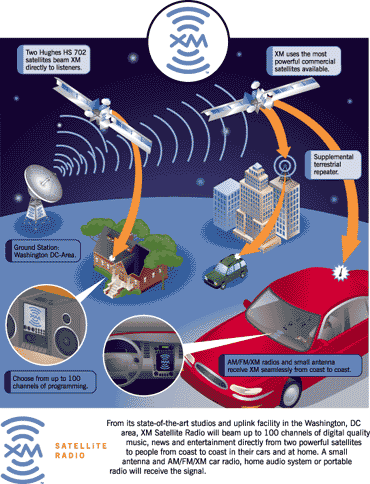
 |
1992 - World Administrative Radio Conference allocated the L-band for worldwide digital radio transmission.
1993 - Public and private broadcasters form Digital Radio Research Inc. (DRRI)
1995 - First commercial terrestrial broadcasts of L-band digital radio begin in Canada, and the first commercial digital radio receivers come on the market for consumers. This began the transition period from analog to digital radio that will result in the complete replacement of AM-FM bands by 2010 in Canada.
1997 - April 2 auction by FCC of two licenses to CD Radio and American Mobile Radio Corporation for Satellite Digital Audio Radio Service (S-DARS) in the S-band. CD Radio submitted a winning bid in the amount of $83,346,000.00 for the 2320-2332.5 MHz portion of the frequency band and American Mobile Radio Corporation (XM Satellite Radio) submitted a winning bid in the amount of $89,888,888.00, for the 2332.5-2345 MHz portion of the band.
1998 - The Advanced Audio Coding, or AAC algorithm used in the demonstrations at National Association of Broadcasters (NAB) for the terrestial In-Band, On-Channel (IBOC) system that will use existing AM and FM bands for digital radio broadcasts in the U.S.
1999 - Oct. 1 - Lucent Digital Radio, Inc., announced its agreement with the National Radio Systems Committee (NRSC), a joint body representing broadcasters and electronics manufacturers, on NRSC's testing schedule for In-Band On-Channel (IBOC) Digital Audio Broadcast systems. Lucent recently conducted tests on National Public Radio (NPR) member station WBJB-FM. These tests were the first time that an IBOC FM system successfully passed a hybrid (both analog and digital) signal over a radio station's antenna and transmitter without affecting the host analog signal. According to the Consumer Electronics Manufacturers Association (CEMA), there are more than 600 million radios in the United States, or more than six per household. More than 235 million Americans tune in to radio broadcasts for a weekly average of 22 hours. (Lucent press release 10/1/99)
1999 - June 15 - Ford Motor Company and CD Radio today announced an alliance to bring digital satellite radio to Ford customers. Ford is partnering with CD Radio to bring customers a revolutionary in-vehicle entertainment service that will include commercial-free music and seamless, coast-to-coast US coverage. Ford vehicles are expected to be the first cars and trucks in the nation to have factory-installed satellite radio receivers. The exclusive agreement includes all seven Ford brands -- Ford, Lincoln, Mercury, Mazda, Jaguar, Aston Martin and Volvo. (Ford press release 6/15/99)
1999- October 26 - XM Satellite Radio signed an agreement with Mitsubishi Electric Automotive America, Inc., to design, develop, produce and marketradios capable of receiving XM's new band of radio. Mitsubishi Electric
2000 - On July 1, a Russian Proton rocket carrying a U.S. telecommunications satellite launched from the Baikonur cosmodrome. International Launch Services (ILS) successfully launched the Sirius-1 digital audio radio service satellite into a geosynchronous transfer orbit for Sirius Satellite Radio, of New York.